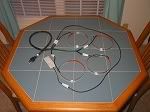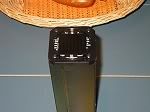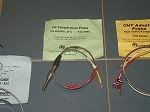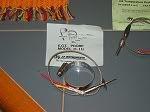Friday, November 16, 2007
Upgrades
I'm still waiting for the shop to find time in their schedule to put Yellowbird back together. For the past three months, I've tried several tactics for dealing with flying withdrawal. I've painted what was paintable fixed what was fixable, and replaced what was replaceable, within the allowances for preventative maintenance spelled out the federal regulations. I've fondled various dismembered airplane parts and dreamed of the day when they would be joined together and whooshing through air as God and Cessna intended. And still it's going to be another month or so before Yellowbird is back in one piece.
In need of some form of aviation therapy, I've turned to shopping. The bank account is already bleeding profusely from the expense of fixing the cracked crankcase, but a few more digits won't be missed, right? I can justify the expense to an extent because with the engine off its mounts, installation will be slightly less expensive. And when you add up the money I've saved by not flying for several months, I think I've almost covered the purchase price of a few extra gadgets.
 First, a Reiff preheat system. We used to have a basic oil pan heater of unknown origin that was installed to replace a Tanis system that was removed when the engine was overhauled in 2001. The oil pan heater did a decent job of warming the oil, but it did little to warm the rest of the engine. I had toyed with a propane fired torpedo heater, ducted through some flexible ducting, but it wasn't very portable, and I was never too keen about pumping superheated fumes (they were hot enough to singe the grass) into the engine compartment. The standard Reiff system includes a heating element for the oil pan as well as heating bands that wrap around the base of each cylinder. This compares to the typical Tanis setup, where the cylinders are heated by elements that plug into the cylinder head temperature probe sockets. I won't attempt a comparison between the two manufactures, but I selected the Reiff system in part because I wanted to keep the CHT sockets available for the next item in our upgrade...
First, a Reiff preheat system. We used to have a basic oil pan heater of unknown origin that was installed to replace a Tanis system that was removed when the engine was overhauled in 2001. The oil pan heater did a decent job of warming the oil, but it did little to warm the rest of the engine. I had toyed with a propane fired torpedo heater, ducted through some flexible ducting, but it wasn't very portable, and I was never too keen about pumping superheated fumes (they were hot enough to singe the grass) into the engine compartment. The standard Reiff system includes a heating element for the oil pan as well as heating bands that wrap around the base of each cylinder. This compares to the typical Tanis setup, where the cylinders are heated by elements that plug into the cylinder head temperature probe sockets. I won't attempt a comparison between the two manufactures, but I selected the Reiff system in part because I wanted to keep the CHT sockets available for the next item in our upgrade...
 Here we have a JPI EDM-700 digital engine monitor. This will replace the original Alcor exhaust gas temperature gauge and probe currently fitted to cylinder #3. The EDM-700 will monitor exhaust gas temperature and cylinder head temperature for all four cylinders. I also sprung for the oil temperature and carburetor temperature sensors.
Here we have a JPI EDM-700 digital engine monitor. This will replace the original Alcor exhaust gas temperature gauge and probe currently fitted to cylinder #3. The EDM-700 will monitor exhaust gas temperature and cylinder head temperature for all four cylinders. I also sprung for the oil temperature and carburetor temperature sensors.
 The box itself. Not too exciting when it's off, but when everything is plugged in and running, it will look like this
The box itself. Not too exciting when it's off, but when everything is plugged in and running, it will look like this
 The cylinder head temperature sensors screw into threaded sockets on the underside of each cylinder head. I'm not sure what "Bayonet" means in this context - it wouldn't look very threatening fixed to the end of a rifle, and it's nothing like a standard bayonet mounting.
The cylinder head temperature sensors screw into threaded sockets on the underside of each cylinder head. I'm not sure what "Bayonet" means in this context - it wouldn't look very threatening fixed to the end of a rifle, and it's nothing like a standard bayonet mounting.
 For an additional price, you can have the EDM-700 certified to replace the factory CHT setup, but I'm shedding enough money as it is. Instead, this adapter allows the EDM-700 to share the same socket on the cylinder with the factory CHT probe.
For an additional price, you can have the EDM-700 certified to replace the factory CHT setup, but I'm shedding enough money as it is. Instead, this adapter allows the EDM-700 to share the same socket on the cylinder with the factory CHT probe.
 As the little green card says, this is the oil temperature sensor. Part number 400505. L and C presumably stand for Lycoming and Continental.
As the little green card says, this is the oil temperature sensor. Part number 400505. L and C presumably stand for Lycoming and Continental.
 The exhaust gas temperature probe goes into a small hole drilled into each exhaust riser, just like in the picture. The clamp holds it in place.
The exhaust gas temperature probe goes into a small hole drilled into each exhaust riser, just like in the picture. The clamp holds it in place.
 Arriving too late for the original photo shoot, the carburetor temperature probe goes into a hole thoughtfully provided in the carburetor. The idea is to keep an eye on the temperature in the throat of the carburetor, where frost can grow when sufficient moisture is present in the air and the temperature in the carburetor throat is below freezing (which can occur even when the outside air temperature is above freezing). Carburetor ice is a real threat for many piston engine aircraft, and is blamed for several accidents, including the 1939 crash which destroyed the prototype of the P-38 Lighting fighter of W.W.II fame. Under the right conditions, ice can build up to the point where necessary airflow into the engine is restricted or even completely cut off, resulting in loss of engine power and possibly complete engine stoppage. The normal precaution is to apply carburetor heat (by channeling air warmed by the exhaust into the carburetor intake) during suspect conditions. The carburetor temperature sensor will help identify those conditions.
Arriving too late for the original photo shoot, the carburetor temperature probe goes into a hole thoughtfully provided in the carburetor. The idea is to keep an eye on the temperature in the throat of the carburetor, where frost can grow when sufficient moisture is present in the air and the temperature in the carburetor throat is below freezing (which can occur even when the outside air temperature is above freezing). Carburetor ice is a real threat for many piston engine aircraft, and is blamed for several accidents, including the 1939 crash which destroyed the prototype of the P-38 Lighting fighter of W.W.II fame. Under the right conditions, ice can build up to the point where necessary airflow into the engine is restricted or even completely cut off, resulting in loss of engine power and possibly complete engine stoppage. The normal precaution is to apply carburetor heat (by channeling air warmed by the exhaust into the carburetor intake) during suspect conditions. The carburetor temperature sensor will help identify those conditions.
So there we have it. I'll enjoy looking at these for a few days and then drop them off at the shop. And then the wait continues.

Hi Scott, nice work on the engine replacement. I looked at your site some times to verifie how I could improve my 1974 Cardinal with serial 17702101. I replaced the baffle seal and used yours as example. I also added an engine monitor and it works great. It also pointed out some issues concerning CHT temperatures. My #2 is quite hot (>400°F) in flight. What is your experience with your new engine and the CHT's?
Thanks, Erik
Erik,
So far, the engine has run well. I might see above 400 degrees on cylinders 1 or 4 during climb, but they typically run about 375 in cruise. 1 and 4 seem to be my hottest cylinders. I have the piggyback probe on #3, and it indicates about 50 degrees cooler than the other cylinders when the engine is warmed up. All probes read the same when the engine is cool, so it may be that the factory probe that it fits into is influencing its ability to sense the cylinder temperature.